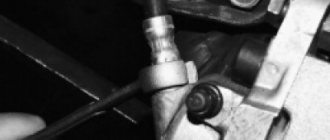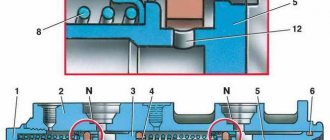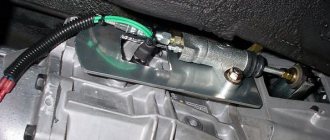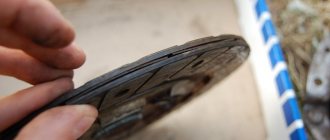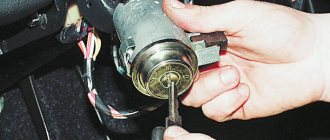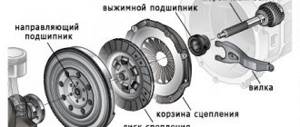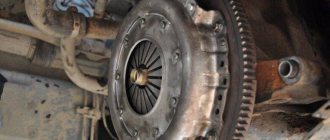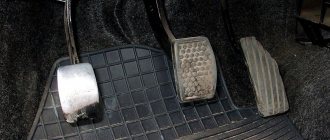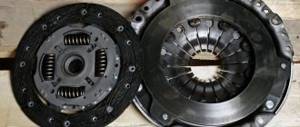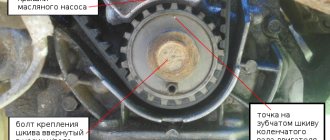What is a hydraulic drive
The clutch in a car is controlled using a pedal. The force from it to the disk can be transmitted in two ways:
- Using a cable.
- Hydraulic drive.
The simplest and most common is the first method, while the “seven” uses the second. Its essence, without going into details, is as follows.
The hydraulic drive consists of two cylinders connected by tubes and hoses. It is designed so that pressing the clutch pedal leads to a significant increase in pressure in the system. It is mechanically transmitted to the driven disk and disconnects the transmission from the engine. The key elements of the system are two VAZ-2107 clutch cylinders: the main and the slave. One of them transforms the force acting on the pedal into excess pressure in the system tubes, the other does the opposite work, acting on the driven disk.
Dismantling the hydraulic drive
The clutch in a car is controlled using a pedal. The force from it to the disk can be transmitted in two ways:
- Using a cable.
- Hydraulic drive.
The simplest and most common is the first method, while the “seven” uses the second. Its essence, without going into details, is as follows.
To perform the operation we will need:
- container for operating fluid and a large-volume syringe.
- set of wrenches and sockets;
- screwdriver and pliers.
The order of work is as follows:
- Brake fluid is pumped out from the expansion tank of the master cylinder of a VAZ 2107 car using a syringe. A rubber tube is disconnected from the drive, from which the remains are also poured into the prepared container. If liquid gets on paint surfaces, they must be wiped with a damp cloth.
- Using an open-end wrench set to “10”, unscrew the fitting of the pipeline connecting the main and working hydraulic drives.
- Using a “13” socket and an extension adapter, unscrew the nuts holding the assembly to the engine compartment panel.
- To remove the master cylinder from the studs, simply press the clutch pedal, this will move it out of place, after which you can pull it out by hand.
The work on removing the unit is completed, and you can begin installing the spare part.
Replacing a mechanism involves purchasing it in a retail network or via the Internet. Installation work is performed in the following sequence:
- The clutch master cylinder of the VAZ 2107 is put on the studs and pushed all the way to the base.
- The nuts are screwed onto the fasteners and tightened with a wrench to “13”.
- The union nut of the pipeline laid to the working hydraulic drive is screwed into the main cylinder.
- The rubber tube is connected to a plastic connecting element and secured with a clamp.
- The expansion tank is filled with brake fluid, which enters the main and slave cylinders of the clutch through tubes. Replacing the fluid in the system is mandatory due to wear products.
More on the topic Changing the automatic transmission oil in Infiniti
Upon completion of installation of parts, it is necessary to inspect and check the tightness of the nuts. Replacing the main or working clutch drive of a VAZ 2107 car ends with bleeding the system.
Clutch design VAZ-2107
The main components of the “seven” hydraulic drive are:
- Main cylinder.
- Metal tube system.
- Clutch slave cylinder VAZ-2107.
- Pedal equipped with a pusher.
- Clutch fork.
The master cylinder is combined with a reservoir into which brake fluid is poured. It is located under the hood of the car, on the wall of the engine compartment. This location allows for a mechanical connection between the cylinder and the clutch pedal. For this, a steel rod, the so-called pusher, is used.
The working cylinder is attached with two bolts to the gearbox housing and is connected to the fork by a rod. The entire length of the metal rod is threaded, which allows you to adjust the clutch. Both cylinders are connected to each other by a copper tube and hoses.
The principle of operation of the VAZ-2107 clutch
The force of pressing the pedal is transmitted via a rod to the master cylinder of the VAZ-2107 clutch. The liquid contained in it is squeezed out into the pipeline. Due to the tightness of the system and the absence of air in it, the force is transmitted to the working cylinder. The rod, extending, acts on the fork, which presses the driven disk. Releasing the pedal causes the rods and brake fluid to move back. As a result, the system returns to its original position.
It is obvious that the basis of the hydraulic clutch drive of the “seven” is the cylinders. They bear most of the load in the form of repeated movement of the rod, during which hydraulic pressure also acts on the internal elements. Therefore, the cylinders are the first to fail. Since they are dismountable, and corresponding repair kits are available for sale, some faults can be repaired yourself. True, more often car enthusiasts prefer to change the entire cylinder.
The fact is that in this case, labor costs for repairs are often inadequate to the cost of the assembled unit. For example, the price of a VAZ-2107 clutch master cylinder is about 1,500 rubles, and you will have to spend a decent amount of time restoring it, especially if you have no experience. However, whether to repair or buy a new one is up to the owner of the “Seven”.
Design and operation of the VAZ-2107 GCS
The clutch master cylinder is a rather complex assembly consisting of a large number of parts. However, in order to understand the principle of operation, it is enough to name the main ones. These include:
- main body with brake fluid reservoir;
- cylinder piston;
- union;
- return spring.
The principle of operation of the cylinder resembles the operation of a conventional piston pump and is as follows: pressing the clutch pedal causes the movement of its pusher, which acts on the piston. Moving forward, it creates pressure in front of itself, which is transmitted through tubes and hoses to the working cylinder. Its rod extends and displaces the clutch fork, the driven disk disengages the transmission. When the pedal is released, the reverse process occurs.
Inspection and repairs
Inspection is an important element in diagnosing the condition of a mechanism, allowing one to draw conclusions about its suitability for further operation, operability, the need for a complete replacement or further direction of work. The mirror (inner part) of the cylinder and the outside part of the piston must be perfectly smooth, without roughness or scratches. A good master cylinder has an internal diameter of 19.05 mm. If there are large scratches, the element will require replacement rather than repair. Minor scuffs and roughness can be sanded with fine-grained sandpaper and oil. First, the edges are rubbed against each other to remove large abrasives.
Inspect the wear of the mechanical elements of the connection and the serviceability of the rubber cuffs. Then the piston return spring is checked; if it loses its elastic properties, it is replaced. The seal rings need to be replaced. It is necessary to inspect the protection cap at the rear end of the mechanism: if there is damage, the part needs to be replaced.
All elements must be cleaned of brake fluid deposits and remnants of decomposed rubber elements. Before reassembly, after checking and replacing damaged or worn elements, all components are washed exclusively with brake fluid, since kerosene, mineral oil, diesel fuel or gasoline in contact with rubber elements (seals, etc.) cause them to swell and leak out of service.
The last step is to assemble the elements in the clutch master cylinder together in reverse order. In this case, the parts are lubricated either with brake fluid or with a special preservation fluid (NG-213).
Typical faults
A large number of rubber gaskets and seals are used for various seals in the cylinder. Most often, they are the reason for the unsatisfactory performance of the GVC. The symptoms will be the following:
- the clutch does not disengage;
- the pedal is not pressed;
- brake fluid leaks on the cylinder body;
- The clutch pedal does not return to its original position.
Such signs are characteristic not only of a malfunction of the main circulation system. Only leaks of brake fluid on the body indicate it reliably. You will have to repair or change the clutch master cylinder of the VAZ-2107, the price in the second case will be noticeably higher, but the service life will also be longer.
Removal and repair
Regardless of whether the owner decided to restore the GVC or preferred to buy a new one, the first step is to dismantle the old one. To work you will need:
- set of spanners;
- medium sized screwdriver;
- pliers;
- brake fluid for topping up;
- repair kit for clutch cylinder VAZ-2107 (in case of repair);
- small container for draining brake fluid.
The sequence for removing the clutch master cylinder is as follows:
- It is necessary to drain the brake fluid from the reservoir. This can be done using a syringe. However, it will be more professional and faster to loosen the clamp, remove the hose from the fitting and quickly place a suitable container under it.
- Using a 10mm open-end wrench, unscrew the metal tube from the main center and move it to the side.
- Using a 13mm socket, unscrew the two nuts securing the cylinder to the engine compartment bulkhead.
- The GCS can be removed.
First of all, the cylinder must be inspected. This will help you decide on repair or replacement. It makes sense to restore the cylinder only if the rubber seals are worn out. The work is carried out in the following sequence:
- Unscrew the plug at the end of the GCS; if necessary, it will have to be clamped in a vice.
- Pull out the return spring.
- Using a screwdriver, remove the rubber cap.
- Now you need to remove the retaining ring.
- Using a screwdriver from the side of the unscrewed plug, push out the cylinder piston.
- Replace all rubber gaskets, rings and seals. To make installation easier, they must be pre-lubricated with brake fluid.
Assembly and installation of the VAZ-2107 clutch cylinder is carried out in the reverse order. After installing the reservoir, it must be filled with brake fluid. True, the clutch will not work yet. Air must be removed from the system.
Self-removal of parts
Having established that there is a problem in this mechanism of the VAZ 2106, in order to carry out repairs, it is necessary to remove it to determine the degree of damage and clean it. To do this, carry out the following steps.
- Unscrew the two nuts of the expansion tank and remove it, putting it to the side.
- Remove the fluid using a rubber bulb from the clutch tank by removing the fluid supply hose (if necessary, the tank is then either unscrewed or left).
- Taking the key to 13, unscrew the tube that goes to the working cylinder and move it to the side. At the same time, make sure that the working fluid from the tube does not get on the disc in the clutch.
- Using a ratchet with a long extension and a 13mm socket, unscrew the 2 nuts securing the damaged device (carefully so that the engraving washers are not lost).
- Remove the element.
It is advisable to have a special wrench for this work, which will not damage the edges of the tube fitting. But when disassembling a VAZ 2106 yourself, you can use regular keys (the main thing is that their edges are not broken) or adjustable ones. The key must securely fix the edges of the fitting.
How to bleed the clutch
Removing air from the system is necessary after any repair of the central circulation system. It is better to carry out work with an assistant. Bleeding the VAZ-2107 clutch cylinder is carried out in the following sequence:
- prepare a small diameter hose and a container with brake fluid;
- fill the tank without adding 1.5 - 2 cm to the top;
- “release” the working cylinder fitting a little and put the hose on it;
- lower its second end into a container with brake fluid;
- press and release the clutch pedal until all the air is released from the system, this can be determined by the absence of bubbles;
- as soon as this happens, you need to fix the pedal pressed and tighten the fitting;
- check clutch operation.
If necessary, the process should be repeated.
Hydraulic clutch bleeding procedure
After replacing or repairing both the main and slave cylinders, the driver will have to bleed the clutch hydraulic drive, since air gets into the machine’s hydraulics. There is no way to avoid this. Therefore, you will have to call your partner for help and start pumping.
Sequence of work
To bleed, you will need the following things: an old plastic bottle, a piece of hose about 40 cm long, a 12 mm spanner.
- The car is installed on the pit and securely fixed. The clutch slave cylinder fitting is clearly visible from the inspection hole. A piece of rubber hose is placed on this fitting so that the fitting nut remains outside. The other end of the hose is placed in a plastic bottle.
The second end of the hose is placed in a plastic bottle - Now the union nut is loosened a couple of turns. After this, the partner sitting in the cockpit squeezes the clutch five times. After pressing for the fifth time, he continues to hold the pedal down.
- At this time, brake fluid with an abundance of bubbles will flow from the hose into the bottle. As soon as it stops flowing, you should ask your partner to squeeze the pedal five more times and then hold it again. This must be done until the liquid coming from the hose stops bubbling. If this has been achieved, pumping is considered complete.
- Now the hose is removed from the fitting, the fitting itself is tightened, and a new portion of brake fluid is added to the reservoir.
So, the master cylinder is the most important element in the VAZ 2106 clutch system. But replacing it does not require special knowledge and skills, so even a novice driver can cope with this task. To successfully replace the cylinder, you just need to be a little patient and strictly follow the above recommendations.
